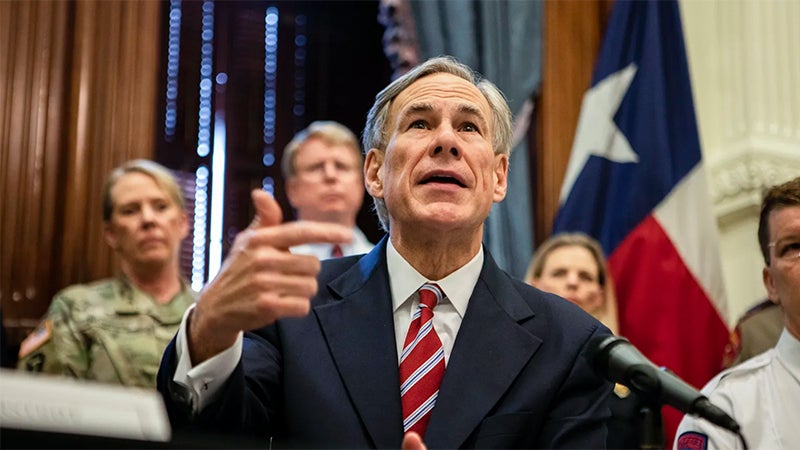Gov. Abbott: Texas doesn’t have to choose between returning jobs or protecting health care
Published 2:10 pm Tuesday, June 16, 2020

- Gov. Greg Abbott declares a statewide emergency amid new cases of COVID-19 in the state on March 13, 2020 at the state capitol. (Eddie Gaspar/The Texas Tribune)
|
Getting your Trinity Audio player ready...
|
Gov. Greg Abbott attributed Jefferson County’s and Texas’ recent spike in COVID-19 confirmations to a federal prison increase locally.
Abbott, speaking Tuesday afternoon at the State Operations Center in Austin, said Jefferson and Pecos counties had an “outsized influence” on the number of Texans testing positive for COVID-19.
For example, a federal prison in Beaumont brought back a batch of positive tests for inmates “that all came in at once.”
“I want you to know that this is the same type of analysis that we use on an ongoing basis as we look into each and every county across the entire state of Texas to figure out exactly what is going on,” Abbott said.
Also on Tuesday, the City of Port Arthur Health Department received confirmation of nine additional Port Arthur residents who tested positive for coronavirus (COVID-19). These individuals include one female between the age range of 25-30, two females between the age range of 30-35 and one female between the age range of 45-50.
The other individuals include one male between the age ranges of 5-10, 20-25, 25-30, 35-40 and 45-50. For confidentiality purposes, the PAHD is not releasing any additional information to identify these individuals.
This brings the total to 104 individuals who have tested positive for COVID-19 in the City of Port Arthur.
The governor was joined by Dr. John Zerwas, a physician from Richmond who is on a team working to expand hospital capacity and procure needed medical supplies.
Zerwas is the executive vice chancellor for health affairs at the University of Texas System.
They were in a room surrounded by screens that read: Texas Hospital Bed Capacity, June 16, 2020.
Abbott said fewer Texans test positive for COVID-19 than residents in any large state in the U.S. He added Texas has one of the lowest death rates and few Texans who test positive have to go to the hospital in the first place.
Today’s number of positive cases, 2,622, is a new high for Texas, which Abbott says is because of a large number of tests out of an assisted living center in Collin County. Hays County is another example of a large increase, Abbott said.
“It seems like these numbers were batched together and averaged out,” he said.
One day after his comments on 20-somethings testing positive for COVID-19, Abbott reiterated that statement, saying there are multiple reports in certain counties “where a majority of the people who are testing positive in that county are under the age of 30.”
“In addition to those testing positive, are those numbers that you’ve been seeing about an increase in the number of people who are hospitalized because of COVID-19,” Abbott said.
Today’s hospitalization number is 2,518, Abbott said, adding, “That’s really a very small percentage of all the beds that are available.”
Abbott says new medical strategies, treatments and additional PPE have better prepared Texas to respond to COVID-19.
The governor recommended that people stay home, if possible, which he says is especially true for those with an underlying health condition or who are 65 and older.
He reiterated that Texans should wear masks while out in public because asymptomatic people can spread the coronavirus.
“Businesses have learned safe strategies both for their employees as well as their customers to make sure that they’re preventing the spread of COVID-19,” he said.
Abbott says Texas doesn’t have to choose between either returning jobs or protecting health care.
“We do have the tools and the strategies in place where we can achieve” jobs being maintained without jeopardizing public health, he said.
Zerwas’ presentation on hospital bed availability indicated there are 14,993 total beds available in Texas out of the state’s 54,844 beds.
Zerwas says he hopes this is a “comforting message” of the state’s health care system.
Dr. John Hellerstedt, commissioner of the Texas Department of State Health Services, says state officials expected this increase in patients, but: “We are seeing it occurring at a manageable level.”
“The possibility that things could flare up again and produce a resurgence of COVID-19,” which would stress the state’s health care system “is still very real,” Hellerstedt said.





